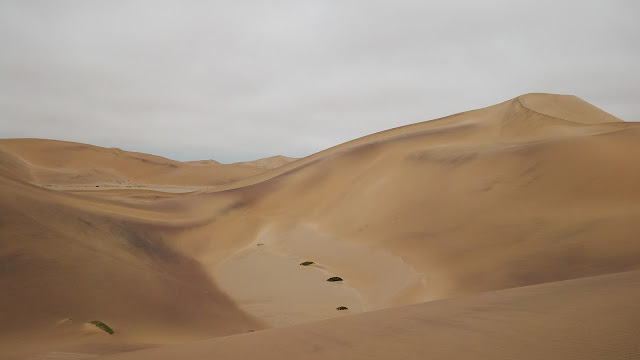Since we first arrived in Zambia nearly two years ago, Rosie and I
planned to end our time here with a trip to a different African country. With
Rosie moving back to the UK before Christmas, it meant that we just had time to
squeeze in a short holiday between the end of term and her flight home.
Before I moved here I thought I would travel around Africa more that I
actually have done in reality, but it’s quite expensive if you don't have your
own vehicle (we currently have use of the Arise vehicle for more local trips
around Ndola and the surrounding areas). I expected flights here to be cheap
like they are in Asia but this isn't the case; probably because the continent
is massive so the distances to travel are much further. Nevertheless, we’d
saved up some money and so we planned a trip to Namibia on the south-west coast
of Africa.
Namibia is the second least densely populated country on earth. It has a
land mass of 826,000km with a population of about 2.3 million people. The
country is home to about 2.5 million seals so there are actually more seals
than people living there!
I hadn’t really anticipated how different Namibia would be in comparison to Zambia. When we arrived in Windhoek, the capital, it struck me how smooth the roads were, how much more developed the town was and how much better it was set up for tourists. It seems a shame that some parts of Zambia aren’t more set up for tourists, as it is such a beautiful country.
 |
The Christ Church (or
Christuskirche), a historic landmark in Windhoek
|
In Namibia we didn’t stick out as much because of our skin colour. In Zambia
it’s a daily occurrence to be pointed at and called ‘muzungu’ (white person)
even after almost two years of living there! However, approximately 10% of the
population in Namibia are white, which includes approximately 50,000 Germans. I
wasn’t struck by the poverty in Namibia which I think is much more obvious in
Zambia. Yet that doesn’t mean it doesn’t exist – perhaps it’s hidden from
tourists or exists in the more remote areas.
 |
First on the bus –
ready for a sweaty journey to Swakopmund!
|
After
staying the night in Windhoek, we travelled on the local bus to the coast, to a
town called Swakopmund. The names of towns in Namibia are a sign of the fact
that the country was a German colony. It gained independence in 1990 but the
Germanic influence is very evident in terms of architecture, and even in the
country's efficiency! Swakopmund is an interesting mix of African and German
cultures.
 |
| The Namibian coast |
 |
| Enjoying Namibian cuisine |
The Namibian landscape is hugely different to Zambia because of the
coast and the desert. I loved being by the sea again, walking along the coast
and eating fresh fish. I particularly enjoyed Namibian fish specialities
Kingklip and Kabeljou. Swakopmund was quite a lot cooler that Windhoek and
Ndola and I think the temperature is more stable there all year round. One day
we took a boat trip where we saw hundreds of seals and flamingos and tasted
fresh oysters which they claimed to be the best in the world. A couple of seals
even joined us on board!
 |
| Rosie, about to try an oyster for the first time |
 |
| This guy joined us on board! |
Much of Namibia is remote. 19% of the land is mountainous and 14% is
covered by sand dunes. The Namib desert dominates the west of the country –
‘Namib’ means ‘vast place’. The sand dunes are created by sand which is
deposited along the shore and then picked up by prevailing south winds and
re-deposited in the form of the massive dunes. Rosie and I went on a 4x4 desert
tour which was really interesting because our Namibian guide was so passionate
about the animals, plants and conservation. We learned that the sand dunes are
gradually being moved by the wind. I was surprised to find out that in twenty
years the dunes may actually reach the local town.
 |
| The sand dunes |
 |
| The edge of the desert creeping close to the town |
The highlight of the trip for me was quad biking around the sand dunes.
It was a great way to take in the scenery, with a little added adrenaline. The
dunes are absolutely huge. For two hours Rosie, our guide and I were zooming
about across the dunes - except on one occasion when Rosie’s quad bike kept
stalling and I nearly crashed into her!
 |
Rosie following our
guide on quad bikes in the sand dunes
|
Five days gave us a good taste of Namibia and was a great way to
celebrate the end of Rosie’s time in Africa. It sounds like there are lots of
other places to see in the country and would be worth driving around if we had
more time. Apparently Namibia is an up and coming destination for tourists. I
can certainly see why! Whilst the landscape and architecture varied greatly in
comparison to Zambia, the friendliness of the African people remained the same.


No comments:
Post a Comment